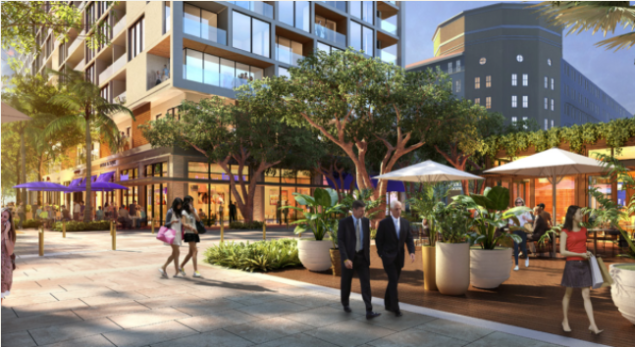

All eyes must be watching the City of South Miami City Commission on November 6 and November 21 when they decide the fate of downtown South Miami. Does the Commission want a City with a vibrant, functional, beautiful downtown or does the Commission want our downtown to continue languishing on the slow road to obsolescence? Does the City want to cut its excellent services or raise property taxes? Does the City want a new hotel or does it want vacant retail? For any intellectually honest person who has paid even two minutes of attention to downtown over the last ten years, the question is a no-brainer. The Commission must vote yes on the plan to reinvigorate the Shops at Sunset Place. A contrary vote is a death-sentence for our City.
The plan is magnificent. It carefully re-integrates the Shops into the fabric of the downtown. It reconnects the property into our downtown street grid. It creates a new majestic plaza/park on San Remo to serve as an anchor for community events, farmers markets, and a place for our citizens to interact with one another. The design leaves the height and scale of Sunset Drive in tact but offers a much needed clean-up of the outdated, themed-pastels that look as tired as they do out of place. Simply put, the new design fosters community engagement while the prior design inhibited it.
The hotel and residential uses should be celebrated. Our City desperately needs a hotel and this is the right place for it. The plan brilliantly locates the hotel directly across the street from the Metrorail at the signature, gateway entrance to our City. The residential buildings are situated where people can actually walk and take the train to work. This is the manifestation of what our community demanded when we voted by a margin of 2-1 to fund the construction of the Metrorail.
The height of the architecture is totally appropriate at this location. It does not negatively impact single-family neighborhoods. In fact, it doesn’t negatively impact anybody at all. By most urban measures, this isn’t even high-rise – it is midrise. In fact, the height is basically invisible from most vantage points within our City – a point elegantly illustrated by the studies included within the application. For your ease of reference, I reproduce it below:
The design allows a critical mass of residents and visitors to reside within our downtown in an efficient, self-sustaining urban district that should drive new business to our existing merchants and restaurant owners. The design is in keeping with well-settled principles of smart growth for compact, urban core development. Smart growth encourages a mix of building types and uses, diverse housing types, and transit options. The design demonstrates allegiance to walkability, connectivity, and mixed-use. This is what we both need and deserve for our downtown.
To those who voice a knee-jerk opposition to the height and falsely equate height and traffic, I would direct you to the professional traffic engineering studies that demonstrate how the mixture of uses proposed for the project effects our critical afternoon rush-hour. It creates no new traffic impacts in the critical pm peak of rush hour. The study prepared by the owners was reviewed by the City’s outside experts. This project will not create a traffic problem. To the contrary, it provides a traffic solution by creating a walkable district with pedestrian access to existing transit service.
From a fiscal perspective, the redevelopment will not only help downtown but it will help every single-family homeowner as well. Every single-family homeowner receives a substantial subsidy from the ad valorem taxes paid by the commercial property owners. The commercial property owners pay approximately 62 cents of every dollar that the City spends to provide services to the residential neighborhoods.
Make no mistake about it, it is the commercial property owners that allow the City to deliver excellent services without raising taxes. But this model depends upon a vibrant downtown with steady increases in property value to cover the steady increases in the cost of providing services. Consider the alternative scenario in the event that the Commission does not approve the project. Existing tenants will abandon their leases, terminate them, or elect not to renew them. Vacancies will increase and property values will decrease. As property values decrease, so too do ad valorem revenues. That leaves the City on the horns of a dilemma: Either increase taxes or decrease services? No responsible elected official should put the City in such peril and all should be watching the Commissioners to ensure that they do not.
This is a moment in our history that transcends politics. It is with our strongest possible conviction that we urge the City to approve the Shops.







Comments are closed.